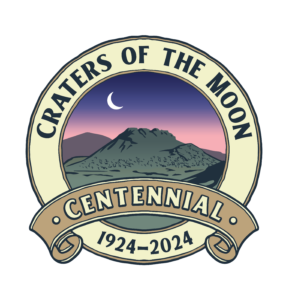By MIKE MCKENNA
 Craters of the Moon is getting ready to celebrate a pretty big birthday.
Craters of the Moon is getting ready to celebrate a pretty big birthday.
The National Monument and Preserve turns 100 on May 2, 2024, and the Centennial will be honored with special events from May through September.
“There’s a bit of awe and a bit of wonder in a landscape that’s pretty much unlike any other place on earth,” said Wade Vagias.
Wade is the superintendent for Craters of the Moon as well as the Hagerman Fossil Beds National Monument and Minidoka National Historic Site. Wade’s career with the National Park Service includes time working in Washington, D.C., and at Yellowstone and Bryce Canyon national parks before landing in the Snake River Plain. But since taking over Craters in 2015, it’s clear that southern Idaho’s beloved—and often overlooked—National Monument has become a magical place for him.
“It looks like a barren wasteland at first glance,” Wade said. “But it’s really a vibrant landscape that’s in perpetual change.”
The Monument covers over 750,000 acres, having been expanded by four different Presidents over the last century. The core of the Monument was created by eight major lava eruptions over the last 15,000 years. Craters’ central feature is the “Great Rift,” a 52-mile-long crack in the earth’s crust. Although the terrain looks barren and brutal to navigate, it’s actually teeming with life.
More than 750 types of plants can be found at Craters as well as a wide variety of wildlife—from bats to bobcats, coyotes to cottontails, skunks, snakes and all kinds of birds. There are even a couple species that can only be found at Craters of the Moon. A subspecies of the Great Basin pocket mouse and yellow pine chipmunk (as well as possibly a unique population of pikas and lava tube beetles) are found nowhere else on the planet.
With a landscape that literally looks out of this world, NASA has used Craters to help prepare for space exploration for over 50 years. This includes training for the Apollo 14 crew, whose successful mission to the Moon involved the first golf balls ever hit in space.
For what it’s worth, Native American legend has it that Craters of the Moon was created by a huge serpent that crushed a mountain and that its ribs and bones can still be seen in the lava rocks.
No matter the season, there’s always something cool to see at Craters of the Moon.
“It’s quite unlike any other place in the lower 48 states,” Wade said, noting that in the spring, the contrast of dark lava, snow-capped peaks in the background and swaths of colorful flora popping up is stunning.
“In the spring, the landscape is like an emerald,” he said.
The Craters of the Moon Centennial celebration schedule revolves around monthly themes: May is Rich Cultural History; June is Tranquil Wilderness; July is Robust Research; August is Explosive Geology; and September is Expansive Night Sky.
If you’ve never been to Craters, or haven’t been in a while, this year is the perfect time to “Take a trip to the Moon!”
The Monument is open every day of the year.

